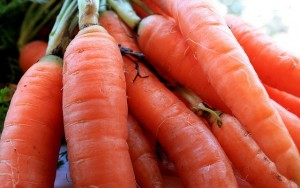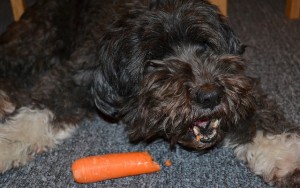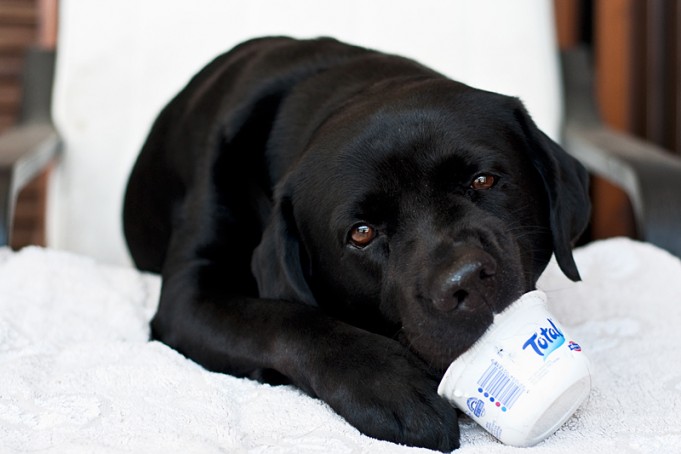Everyone can agree that a well-mannered dog is more enjoyable to be around than a poorly-mannered dog, but teaching a dog even the most basic of commands requires dedication, time, patience, and treats.
Many, many dog treats.
All the calories in those treats can add up quickly, and if your dog just can’t seem to grasp the idea of sit, his belly may be sitting on the ground whether he’s sitting or not. Treats and snacks should only make up about 10 percent of your dog's daily calorie intake.
In order to figure out just how much that should be, you'll need to discuss your dog's diet with your vet. They can calculate approximately how many calories your dog should be eating in a 24 hour period.
 To help cut down on those calories, put the training treats aside and head to your refrigerator. Odds are, in the crisper drawer with the lettuce, or on the second shelf next to last night’s leftovers, you have my low-calorie superfood training secret: carrots.
To help cut down on those calories, put the training treats aside and head to your refrigerator. Odds are, in the crisper drawer with the lettuce, or on the second shelf next to last night’s leftovers, you have my low-calorie superfood training secret: carrots.
You read that correctly. Whether you buy full carrots, baby carrots, or carrot chips, you have a great alternative for training treats just chilling in your kitchen – pun intended.
My Low-Calorie Superfood Secret To Training A Dog
Just like you, your dog only requires a certain number of calories every day. Any extra calories that he eats must be burnt off with exercise or his body will begin storing them as fat. Being overweight is just as detrimental to a canine's health as it is to a humans.
Your dog's entire body is negatively impacted if he is overweight. It will effect his heart, digestive tract, vital organs, bones and joints, and even his energy level. Being overweight can cause serious health issues, including taking years off your dog's life.
RELATED: How to Read Dog Food Labels
That's why it's so important to feed your dog a well-balanced diet, and I'm not just talking about the food you feed him. You need to be conscious of the calories in his treats as well. That's why I use carrots instead of training treats or standard dog treats that can contain upwards of 25 calories per treat.
How Does It Work?
Just like any training treat, when your dog obeys your command, he gets a treat. That’s the easy part.

The hard part – which is actually pretty easy (I like to keep things simple) – is making sure the bits of carrot you’re feeding your dog are the proper size. You don’t want to cut the carrots too small; otherwise, your dog could choke. You don’t want to cut the carrots too big either; otherwise, your dog will be chomping on a treat for 30 seconds while you’re ready to give the next command.
Since there are so many different sizes of dogs, I can’t really tell you what size you should cut your carrots down to. I use sliced-up baby carrots when training my Shih Tzu and whole baby carrots as an occasional just-because treat.
Start out with the the size that you believe will be best for your dog and then go from there. If it seems a little small, make them bigger next time. If it seems to take him a while to chew it up, make it a little smaller next time.
[optin-monster-shortcode id=”mmevqhqfl46p1is5″]
Does It Work For All Dogs?
While carrots are a great alternative to traditional training treats, some dog owners should steer clear from this superfood in their dog’s best interest.
Owners of puppies – Although puppies love to chew, carrots shouldn’t be used for training until they are fully weaned from soft foods and are receiving their daily nutrients from kibble. This will reduce the risk of choking.
Owners of senior dogs – You may want to teach your old dog new tricks, but senior dogs that have a hard time chewing kibble or toys should not be trained with carrots. All those years of chewing can wreak havoc on your dog’s teeth and jaws, so unless you want to cook the carrots first to make them softer, a different training treat should be considered. If you do decide to cook carrots for your dog, do not add sugar, salt, or spices. Keep it plain and simple.
RELATED: How to Start a Dog Training Business
Owners of picky dogs – This may seem self-explanatory, but if your dog doesn’t like carrots, then this isn’t the best option for you. After all, we want to reward our dogs for good behavior, not punish them with a treat they don’t like.
If you own a diabetic dog, you know your dog’s diet better than anyone, so the ball is in your court in the decision of using carrots as a training tool. Other than these guidelines, this superfood training secret should work for you and your dog.
What Are The Health Benefits?
By now you may be considering using carrots to train your dog, but you’re not quite sold because you don’t know what’s so super about this superfood. Well, hold tight, my friends, because I’m going to rattle off the benefits faster than an auctioneer, and I bet I’ll have you sold by the end.
First of all, carrots are low in calories. A medium-sized carrot has 25 calories, and a baby carrot only has four calories. Once you cut the carrots down to the ideal size for your dog, the calorie count will be even lower!

Carrots are also PACKED with nutrients. They are rich in the following vitamins:
- Vitamin A: Promotes healthy skin and coat, helps prevent night blindness, and supports healthy growth.
- Vitamin B1: Aids in digestion; promotes healthy skin, coat, eyes, liver, nervous system, and immune system.
- Vitamin B6: Reduces risk of anemia, promotes growth and skin health.
- Vitamin C: Boosts immune system.
- Vitamin D: Regulates calcium and phosphorus levels in the body, aids in nerve and muscle control, and promotes strong bones.
- Vitamin E: Promotes cardiovascular health, connective tissue health, fertility, and immune system health; aids in digestion, and slows the aging process.
- Vitamin K: Helps prevent osteoporosis and ensures blood clotting.
Carrots will also help your dog maintain good dental hygiene. Munching on carrots exercises the teeth and jaws, keeping them strong. The crunching and rubbing of the carrots against the teeth may also help remove plaque.
RELATED: Why Are Dogs Eating Grass?
My favorite thing about carrots is that you can share them with your pet. There’s no need to worry if you get hungry during training. I’m sure you can sneak a bite or two without your dog seeing…maybe! Not only can you satisfy your hunger, but sharing food will also foster the bond that you have with your pup.
They’re low in calories, packed with vitamins that promote everything from coat health to cardiovascular health, help maintain a healthy mouth, and you can share them. I know what you're thinking, carrots seem to have scored across the board!
Carrots aren't the only superfood you can use for dog treats
Many dog owners don't realize this, but there is another way to look at dog treats, as Tony Buffington, DVM, PhD, professor in the veterinary clinical services department at Ohio State University says…
“Treats are things that bring joy; they don't have to be food. If you want to provide your dog with a good treat, then take him for a walk or teach them a new trick. Your dog wants your attention and time far more than he wants a snack.”
Treats don't have to be the only way that you reward your dog. Your attention is just as important to your pet as eating a treat. Maybe your dog loves to tug or play fetch. If he does something worth rewarding, like if he has a really great training session, bring him outside and spend some time playing with him. That will mean more to both of you than rewarding him with a treat.
RELATED: Dog Nutrition 101: How to Feed a Dog
Of course, sometimes you're going to feed your dog a treat as a snack or to reward him for good behavior. Store bought treats are not only high in calories, but they also contain artificial flavors, preservatives, and sugar. Carrots are a great substitute, but you can also give your dog a little variety by feeding them green beans or broccoli too.
Some fruits like banana slices, berries, watermelon, and apples also make great dog treats. Just remember to steer clear of grapes, raisins, and onions – they can be toxic to dogs.
In all fairness, it should be noted that fruits and vegetables – like all things in life – should be used in moderation. Remember, there is such a thing as too much of a good thing. Carrots, and other veggies, are high in carbohydrates and fruits contain a lot of natural sugars, so you should never feed your dog a large amount in a single setting.
If you’re going to use them for training and as an occasional treat like I do, you shouldn’t have anything to worry about. I hope my low-calorie superfood secret to training a dog helps make the bond between you and your dog grow stronger.
Happy training!













